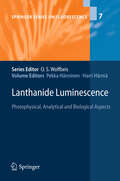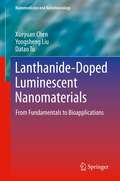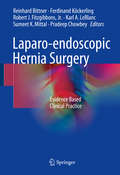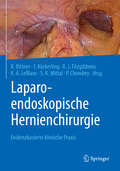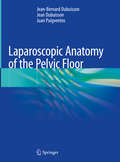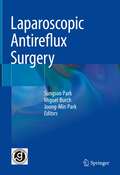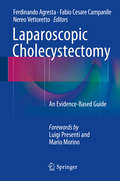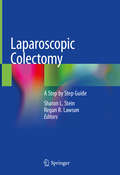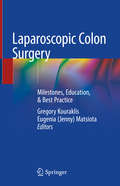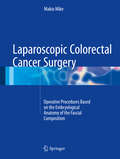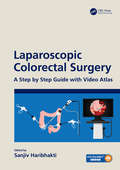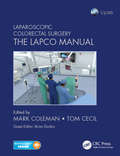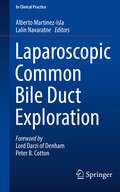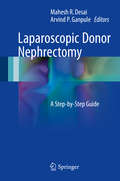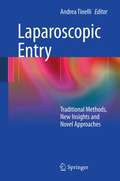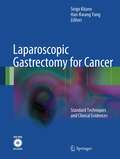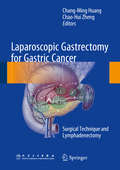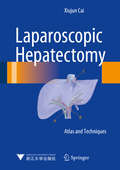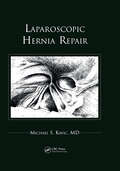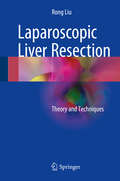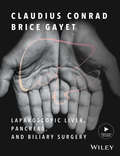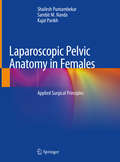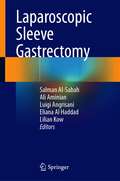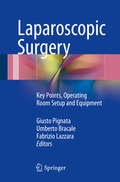- Table View
- List View
Langzeitresultate in der Extremitäten- und Wirbelsäulenchirurgie
by Hans-Kaspar Schwyzer Beat René Simmen Rainer-Peter MeyerIn diesem Buch präsentieren 38 renommierte Orthopäden 38 beeindruckende Langzeitverläufe in der operativen Orthopädie und Unfallchirurgie:· Das Nicht-Kennen-Wollen unserer Langzeitresultate ist wie das Verdrängen unseres eigenen beruflichen Werdeganges.· Aus der Langzeitdokumentation holen wir unsere Sicherheit, dem medizinisch-industriellen Komplex mit all seinen kurzlebigen technischen Neuerungen gegenüber kritisch zu sein.· Das Erarbeiten von Langzeitresultaten manifestiert die hohe Eigenverantwortung, die wir unseren Patienten gegenüber haben.Ein Plädoyer für mehr Engagement bei Archivierung und Analyse von Langzeitverläufen!
Lanthanide Luminescence
by Pekka Hänninen Harri HärmäLanthanides have fascinated scientists for more than two centuries now, and since efficient separation techniques were established roughly 50 years ago, they have increasingly found their way into industrial exploitation and our everyday lives. Numerous applications are based on their unique luminescent properties, which are highlighted in this volume. It presents established knowledge about the photophysical basics, relevant lanthanide probes or materials, and describes instrumentation-related aspects including chemical and physical sensors. The uses of lanthanides in bioanalysis and medicine are outlined, such as assays for in vitro diagnostics and research. All chapters were compiled by renowned scientists with a broad audience in mind, providing both beginners in the field and advanced researchers with comprehensive information on on the given subject.
Lanthanide-Doped Luminescent Nanomaterials
by Xueyuan Chen Yongsheng Liu Datao TuLanthanide-Doped Luminescent Nanomaterials reviews the latest advances in the development of lanthanide-doped luminescent inorganic nanoparticles for potential bioapplications. This book covers the chemical and physical fundamentals of these nanoparticles, such as the controlled synthesis methodology, surface modification chemistry, optical physics, and their promising applications in diverse bioassays, with an emphasis on heterogeneous and homogeneous in-vitro biodetection of tumor biomarkers. This book is intended for those readers who are interested in systematically understanding the materials design strategy, optical behavior of lanthanide ions, and practical bioapplications of lanthanide nanoparticles. It primarily focuses on the interdisciplinary frontiers in chemistry, physics and biological aspects of luminescent nanomaterials. All chapters were written by scientists active in this field and for a broad audience, providing both beginners and advanced researchers with comprehensive information on the subject. Xueyuan Chen is a Professor at Fujian Institute of Research on the Structure of Matter (FJIRSM), Chinese Academy of Sciences. Yongsheng Liu is a Research Associate Professor at FJIRSM, Chinese Academy of Sciences. Datao Tu is a Research Assistant Professor at FJIRSM, Chinese Academy of Sciences.
Laparo-endoscopic Hernia Surgery: Evidence Based Clinical Practice
by Karl A. LeBlanc Reinhard Bittner Ferdinand Köckerling Pradeep Chowbey Robert J. Fitzgibbons Jr. Sumeet K. MittalThis book is distinctive in that it focuses exclusively on current laparoscopic and endoscopic techniques for inguinal, primary and incisional abdominal wall, and hiatal hernias. Individual steps in diagnosis and treatment are described by experts in the field, but this clinical expertise is also integrated with the best available external evidence from systematic research as encapsulated in statements, recommendations, and guidelines. The reader will thus not only learn how to perform techniques systematically and reproducibly but also come to understand which of the procedures have been scientifically validated by studies, reviews, and meta-analyses and which have simply developed empirically. The descriptions of technique are supplemented by detailed guidance on such aspects as indications, anesthesia, aftercare and pain management, and the prevention and management of complications. Where appropriate, careful comparisons are made of competing repair options, including open techniques. In summary, this book will help practicing surgeons to standardize their operative technique so as to reflect current scientific knowledge and thereby improve the quality of laparoscopic/endoscopic hernia surgery.
Laparo-endoskopische Hernienchirurgie: Evidenzbasierte Klinische Praxis
by Karl A. LeBlanc Reinhard Bittner Ferdinand Köckerling Robert J. Fitzgibbons Sumeet Mittal Pradeep ChowbeyDiagnostik und laparoskopische Therapie von Leistenhernien, Bauchwand- und Narbenhernien sowie Hiatushernien werden Schritt für Schritt und mit zahlreichen Abbildungen von einem internationalen Expertenteam beschrieben. Neben den etablierten Verfahren sind auch neu entwickelte Operationstechniken und das Vorgehen bei atypischen und komplexen Hernienformen dargestellt, ebenso die Prävention und Behandlung von Komplikationen. Der Netztechnologie ist zu jedem der Hauptthemen ein eigenes Kapitel gewidmet. Vor- und Nachteile der einzelnen Behandlungsformen werden diskutiert und verglichen. Jedes Kapitel nimmt dabei Bezug auf die anerkannten Leitlinien der Fachgesellschaften und die relevanten Studien, Übersichten und Metaanalysen und bezieht zugleich die Erfahrungen und Empfehlungen renommierter Hernienchirurgen ein. Standardisierte Operationstechnik und evidenzbasierte Entscheidungsfindung tragen zur Verbesserung der Behandlungsergebnisse in der laparo-endoskopischen Hernienchirurgie bei.
Laparoscopic Anatomy of the Pelvic Floor
by Jean-Bernard Dubuisson Jean Dubuisson Juan PuigventosGynaecological surgery has made tremendous strides in the last 30 years, due to advances in medical imaging, operative laparoscopy, and new types of prosthesis. Reconstructive plastic surgery of pelvic organ prolapse and of urinary incontinence have benefited from these developments. The laparoscopic sacropopexy and laparoscopic lateral suspension with meshes are two excellent examples. In order to successfully perform these operations, detailed knowledge of the anatomy of the pelvic floor as “seen from above”, i.e., from the abdominal view, is an invaluable asset. Achieving perfect knowledge of the anatomical details is now possible, thanks to laparoscopy. With the aid of laparoscopy, following subperitoneal dissections, reconstructive surgery of the pelvic floor can be made substantially more precise, more exact, and also more anatomical. This atlas will allow gynaecologic surgeons to deepen and improve their anatomical expertise, with the aid of laparoscopy. It also describes in detail the most common laparoscopic operative techniques. The book represents a new and unique approach to anatomy studied in the living, and supplements the main content with a wealth of straightforward and clearly explained photographs.
Laparoscopic Antireflux Surgery
by Sungsoo Park Miguel Burch Joong-Min ParkThis book provides detailed, up-to-date information on gastroesophageal reflux disease (GERD) and all aspects of laparoscopic antireflux surgery. Clear descriptions of surgical techniques and important surgical tips are combined with state of the art research results to create a unique resource for general surgeons and other health care providers. The book opens by presenting the latest knowledge on the pathogenesis of GERD, identifying the target symptoms, and explaining diagnostic tests and their interpretation. The various techniques of fundoplication are then clearly described and illustrated, with provision of advice on the postoperative clinical pathway and the management of complications. Laparoscopic revision of failed antireflux surgery is fully covered, and the use of antireflux surgery in specific situations, such as achalasia and paraesophageal hernia, is discussed. The relationship between sleeve gastrectomy and GERD is also explored. Finally, guidance is provided on magnetic sphincter augmentation using the LINX Reflux Management System and on other emerging surgical options.
Laparoscopic Cholecystectomy
by Ferdinando Agresta Fabio Cesare Campanile Nereo VettorettoThis book, written by expert surgeons, offers a comprehensive and up-to-date overview of all aspects of laparoscopic cholecystectomy. Coverage includes the indications for surgery, anesthesia, surgical technique, and the prevention and management of complications, with extensive reference to the latest clinical evidence and assessment of the benefits of the laparoscopic approach, for example in terms of outcomes and day surgery. New technologies, including SILS, NOTES, robotic surgery, and miniaturized instruments, are reviewed. The learning curve and training are also extensively discussed, and an individual chapter is devoted to the views of international experts in the field. Readers will find the book to be an ideal guide to this gold standard technique, which continues to evolve some 20 years after the National Institutes of Health Consensus Conference first published recommendations regarding indications for laparoscopic cholecystectomy.
Laparoscopic Colectomy: A Step by Step Guide
by Sharon L. Stein Regan R. LawsonThis book is designed specifically to help equip new surgeons with the anatomical and technical knowledge to supplement hands on experience in minimally invasive colon and rectal surgery. There are multiple colorectal surgeries which distinctly lend themselves to the use of the laparoscopic approach. To assist the junior surgeon who is embarking on a career in surgery, expert surgeons and educators in the field of colon and rectal surgery from around the country authored the chapters included in this book. Chapters describe key elements of each surgery, including the order of surgery, when and how the surgeon created tension, rotated the patient, and optimized flow of the surgery. Chapters also contain tips and pitfalls that are not always explicitly presented when describing a surgical approach in order to provide readers with a diverse toolkit. Each chapter is also full of new illustrations that show the direction of traction, the line of dissection, and the anatomy of the colon. The illustrations also present tools in a color-coded format to clearly distinguish between the surgeon’s and the assistant’s tools. Laparoscopic Colectomy: A Step by Step Guide is a valuable resource to residents and junior attendings who wish to master laparoscopic colon and rectal surgery.
Laparoscopic Colon Surgery: Milestones, Education, & Best Practice
by Gregory Kouraklis Eugenia Jenny MatsiotaThis book is the structured, comprehensive work of experienced surgeons and constitutes the condensed and succinct epitome of knowledge and guidance for those interested in Laparoscopic Colon Surgery (LCS), focusing only on colon laparoscopy. The milestones in LCS are presented offering valuable background information about the evolution of LCS throughout the years and presenting how it still has a limited application, no matter the need for minimal invasive, fast-track, surgical procedures that can offer better quality to patients and less cost for any healthcare system. The book aims to highlight the preferred diagnostic procedures, the right methods for the efficient and rational selection of patients, the choice of the best surgical techniques and treatments, and the best management of post-operative complications for an early discharge. It provides adequate information to the surgeons or the surgical residents interested in LCS about how to select, what to avoid, what instruments to use, what techniques to follow, how the evaluation of patient’s anatomy can lead to better surgical planning, and the add-on of robotic colon surgery in the quality of patients’ life. Moreover, the book provides information about the most efficient anaesthesia adequate for LCS; information that most books of its kind do not include. Finally, the book provides excellent information about the best education and practices to be followed in LCS; something of special importance after considering the level of difficulty associated with LCS and the high conversion rate compared to other laparoscopic procedures. Although the primary focus of this book are surgeons (LCS, GI, General) and surgical residents, the content still can offer valuable information to these healthcare leaders who are interested in understanding the milestones and benefits of the right model of education, and the best practices related to LCS.
Laparoscopic Colorectal Cancer Surgery
by Makio MikeThis unique guide describes colorectal surgery procedures using medical terminology and anatomical terms originating from embryology. In the last decade, laparoscopic procedures in gastrointestinal surgery have been enhanced and their safety has significantly improved. With the number of cases of colorectal cancer surgery increasing and laparoscopic surgery no longer considered a specialized surgery, the recognition of the correct anatomy is vital in these procedures. Unfortunately, however, the understanding of clinical anatomy is frequently separate from that of basic surgical concepts. Initially, the dissecting layer should be presumed to derive from the fascial anatomy based on embryological recognition. Furthermore, the techniques currently being used by surgeons should be described in sufficient detail and the appropriate anatomical terms should always be used. In view of this, this valuable monograph benefits gastrointestinal surgeons and general surgeons who are involved in the treatment of colorectal cancer.
Laparoscopic Colorectal Surgery: A Step by Step Guide with Video Atlas
by Sanjiv HaribhaktiThis comprehensive book provides the reader a perspective of the current evidence-based management of Laparoscopic Colorectal Surgery. It covers sections on benign surgery for IBD, diverticulitis, rectal prolapse etc. along with the procedures for colon and rectal cancers, including laparoscopic TME. The accompanying videos complement the text imparting specific operative skills of exposure, retraction, countertraction, dissection, vascular control, hemostasis, laparoscopic Stapling, anastomosis, specimen extraction and stoma formation. This book aims to help surgeons to learn, standardize, practice and master the complex skills of Laparoscopic colorectal surgery. Key Features Provides step by step solution to the difficulties encountered by the beginners by covering a section on bugbears. Caters to General, GI, Oncology and Colorectal surgeons who have the adequate basic laparoscopic skills and have already been doing some advanced laparoscopic surgery in form of laparoscopic Upper GI and bowel surgery and would want to start laparoscopic colorectal surgery. Covers a section on Robotic and single incision laparoscopic surgery providing the contemporary knowledge in this emerging field, whereas a section on trans-anal surgery provides a futuristic dimension to this field.
Laparoscopic Colorectal Surgery: The Lapco Manual
by MARK COLEMAN AND TOM CECILThis unique reference in laparoscopic colorectal surgery starts by looking at the establishment of the Lapco training programme in the UK. It then goes on to provide a comprehensive technical manual of operative and patient care for laparoscopic colorectal surgery, offers insight into training and assessment methodology and finally looks to the future and where we may be going. It shares knowledge of a unique training programme which healthcare systems worldwide are trying to emulate, and provides an up-to-date manual of know-how from some of the world’s most experienced laparoscopic colorectal trainers.
Laparoscopic Common Bile Duct Exploration (In Clinical Practice)
by Alberto Martinez-Isla Lalin NavaratneThis book provides a concise overview of several critically important techniques and their applications within Laparoscopic Common Bile Duct Exploration (LCBDE). LCBDE is rapidly emerging as the preferential management option for treating patients with common bile duct (CBD) stones. Chapters within this book describe how this technique can be applied to manage patients with concomitant gallstones, which aims to increase the exploration of the CBD via the transcystic route. Particular mention is made for the use of energy devices to enable stone fragmentation within the bile duct also known as Lithotripsy-Assisted Bile duct Exploration by Laparoendoscopy (LABEL). Guidance is also provided on how to set-up an acute biliary service which can offer the single-stage management of concomitant gallstones and choledocholithiasis. The concepts of ‘Leveraging Access to Technology and Enhanced Surgical Techniques (LATEST)’ in LCBDE and ‘Biliary Surgery 2.0’ as the framework through which these techniques can be further enhanced are analysed. Laparoscopic Common Bile Duct Exploration features insight into how to perform these increasingly important procedures successfully and set-up a service within institutions that are yet to provide it. Therefore, it is a valuable resource for all medical professionals involved in the care of these patients.
Laparoscopic Donor Nephrectomy
by Mahesh R. Desai Arvind P. GanpuleThis book explains the development of various laparoscopic donor nephrectomy (LDN) techniques, which can be performed via the retroperitoneal or the transperitoneal approach. It provides a step-by-step explanation of LDN, including details of intricacies such as port positioning, dissection steps, securing the hilum and retrieval. It also reviews new techniques like robotic donor nephrectomy and single-port donor nephrectomy. Lastly, it explores the non-technical but equally important issues of donor work-up and legal and social aspects. LDN is a unique surgical procedure in which the surgeon operates on an individual who is not a patient but someone donating out of altruistic motives, and it has to be "zero error" for the safety of the graft, donor and the recipient. This handbook is a valuable resource for urologists, general and transplant surgeons as well as anesthesiologists and medical social workers working in the field.
Laparoscopic Entry
by Andrea TinelliLaparoscopic Entry: Traditional Methods, New Insights And Novel Approaches discusses traditional methods of laparoscopic surgery, new devices, laparoscopic entry in difficult patients, robotic assisted surgery access, single port entry, gasless access, transvaginal entry and natural orifice surgery. This book illustrates, through the presentation of techniques, methods, photos, images, drawings and pictures, all the possible methods of laparoscopic entry for endoscopic surgeons, either for laparoscopy or for robotics. Laparoscopic Entry: Traditional Methods, New Insights And Novel Approaches describes problems and criticisms of each method and highlights common and rare complications.Written by experts in the field, this book also includes tips and tricks, which can be tailored to each patient, making it a valuable reference tool for gynecologists, urologists, vascular and general surgeons.
Laparoscopic Gastrectomy for Cancer
by Seigo Kitano Han-Kwang YangThe first laparoscopy-assisted gastrectomy for gastric cancer was performed in Japan in 1991. In the ensuing 20 years, at first through a process of trial and error, then through the sharing of master surgeons' accumulated experience, the procedure has been honed and refined to its current high level. From the beginning, it soon became evident that this much less invasive form of gastrectomy, in comparison with traditional open surgery, led to improved quality of life for postsurgical patients, and use of the procedure spread rapidly among gastric surgeons. Early on, however, there were calls for the establishment of standard techniques and procedures to be followed, with a recognized need to improve the level of safety and the quality of lymph node dissection for local control in cancer treatment. Toward that end, the Laparoscopy-Assisted Gastrectomy Club was formed in 1999. In the following year, because both Japan and Korea experience a high rate of gastric cancer, specialists from those two nations came together to form the Japan-Korea Laparoscopic Gastrectomy Joint Seminar, to facilitate and encourage the exchange of vital information. The result has been to achieve an evolving consensus among specialists in the field of endoscopic surgery in Japan and Korea with expertise that can be shared worldwide. A compilation of the current state-of-the-art is now presented in this volume, with accompanying DVD, which will be of great value to all endoscopic surgeons who perform laparoscopic gastrectomy.
Laparoscopic Gastrectomy for Gastric Cancer
by Chang-Ming Huang Chao-Hui ZhengThis book presents surgical techniques and detailed illustrations of laparoscopic gastrectomy for gastric cancer, focusing on effective, concise steps and techniques. It describes in detail the perigastric anatomy, and the incidences of each anatomical structure are analyzed statistically. It also discusses lessons learned and best practices in the management of gastric cancer patients, and includes video captures of precise operational techniques -essential resources for gastrointestinal laparoscopic surgeons. Given its close connection to clinical practice, it offers a valuable reference work for general surgeons and residents.
Laparoscopic Hepatectomy
by Xiujun CaiThis book introduces laparoscopic surgeries in liver resection using the technique of curettage and aspiration. Surgical procedures, techniques and special instruments are described in this book. Each step is explained and illustrated with high-quality figures, hand-drawings and videos. This atlas will serve as a step-by-step guide for laparoscopic liver resection.
Laparoscopic Hernia Repair
by Michael S KavicLaparoscopy is increasingly being used as an alternative to more invasive surgical techniques. This book details newly revealed anatomical dynamics of the lower abdominal wall and introduces the reader to laparoscopic repair of the inguinal hernia.
Laparoscopic Liver Resection
by Rong LiuThis book provides a comprehensive guide to the use of laparoscopic resection in the treatment of surgical liver lesions. As it introduces the steps and key techniques of laparoscopic anatomical liver resection, it will be of great interest to surgeons and physicians working in this area. Though each chapter covers a different technique, all chapters are written in a uniform style, including indications and contraindications, surgical steps, key techniques, complications and notes. This book provides readers with an overview of the current state of the art and deeper understanding of laparoscopic liver resections.
Laparoscopic Liver, Pancreas, and Biliary Surgery: Textbook And Illustrated Video Atlas
by Claudius Conrad Brice GayetLaparoscopic Liver, Pancreas and Biliary Surgery: Textbook and Illustrated Video Atlas is the perfect learning tool for all surgeons managing patients requiring advanced liver, pancreas and biliary surgery minimally invasively. This highly immersive text and video atlas will provide surgeons from trainee to advanced levels of practice, including, general surgeons, hepato-pacreatico-biliary surgeons, transplant surgeons and surgical oncologists, with a step-by-step, multi-media teaching atlas on performing laparoscopic liver surgery, anatomically correct, safely and effectively. The atlas will teach the surgeons to perform anatomic liver resections of each liver segment expertly and logically, and will cover lobectomies, extended resections, advanced laparoscopic pancreas surgery (including Whipple) and other procedures. A special emphasis is placed on reproducibility of excellence in surgical technique. Each video will be supported by outstanding illustrations for each technique and 3D renderings of the relevant anatomy. The educational step-by step high-definition videos teach everything you need to know, including critical aspects like patient positioning, port placement, dissection and much more. Led by the pioneers in laparoscopic liver, pancreas and biliary surgery, Brice Gayet and Claudius Conrad, the textbook-chapters will be authored by world experts and will contain surgical tips and tricks garnered from their unique experiences, to improve care, management of complications, relevant society guidelines and excellence in oncologic care for patients with hepato-pancreato-biliary cancers.
Laparoscopic Pelvic Anatomy in Females: Applied Surgical Principles
by Shailesh Puntambekar Sambit M. Nanda Kajal ParikhThis book offers a concise and easy-to-understand overview of facts and concepts in pelvic anatomy. Laparoscopy provides good vision in a limited field, which means that surgeons have to rely on their anatomical knowledge of what structures lie in the vicinity and which structures need to be preserved. Focusing on surgical anatomy, the book helps laparoscopic surgeons better understand the female pelvic structures so improve their surgical skills.
Laparoscopic Sleeve Gastrectomy
by Luigi Angrisani Salman Al-Sabah Ali Aminian Eliana Al Haddad Lilian KowThis book provides a complete guide to laparoscopic sleeve gastrectomy and the management of obesity. The chapters discuss guidelines for healthcare providers for the management of patients with obesity, the rationale behind choosing patients, performing the procedure in line with the patient’s condition, the perioperative period, postoperative requirements, and postoperative complications.This book aims to give readers an understanding of the surgical techniques involved in laparoscopic sleeve gastrectomy and the wider treatment options available. It is relevant to bariatric, metabolic, and general surgeons, physicians, clinical nutritionists as well as students.
Laparoscopic Surgery
by Giusto Pignata Umberto Bracale Fabrizio LazzaraThis book is distinctive in that it is a truly practical guide to use of the laparoscopic approach for the treatment of many abdominal diseases. Rather than simply offering a general description of surgical laparoscopic techniques, it provides the knowledge required in order to introduce basic laparoscopic procedures into daily practice or to commence advanced laparoscopic surgery. For each surgical procedure, key points are highlighted, the necessary equipment is described, and the operating room setup essential to avoid errors or loss of time is explained. Many flow charts, tables, and figures are included to assist fast and intuitive comprehension. The book will be of interest to all of the "actors" in the operating room, including especially surgeons in training, established surgeons, nurses, and anesthetists.

